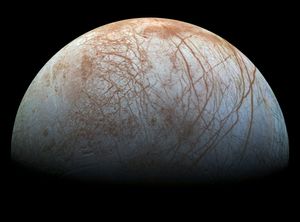
Oct 1, 2023
The Most Likely Candidate for ET Life is Within Our Solar System
No, this isn't some clickbait title, our Solar System may not only harbor life on our planet, but a certain moon may be a good candidate for potential life as well.
The moon in question is none other than Europa. Recently, the James Webb Space Telescope (JWST) found evidence of carbon dioxide on the icy surface, of the Jovian moon. This is significant, as carbon is a crucial building block for any organism, no matter how small or big.

However, while carbon is a crucial piece of the puzzle, other variables need to be achieved in order for a celestial body to harbor life. One of these other important factors is undoubtedly warmth, surely Europa, which is around 5.2 AU (780 million kilometers/500 million miles) from the sun, is too frozen to sustain life, right?
You'd be surprised.
Don't Judge a Book By its Cover
While the surface of Europa looks icy, lifeless and hostile, under the thick layers of ice, may be the perfect habitat for life beyond our planet.
I am referring to Europa's massive underwater oceans. Ever since Voyager 1 flew by Europa in 1979, scientists around the world were intrigued by the crevasses that covered the planet. These crevasses are thought to be created by subsurface ocean activity. This activity below the surface, shifts the ice above. Causing the unique surface features that we see on Europa.
In fact it is believed the carbon buildup we see on the surface, came from the many crevasses that cover the moon.

These subsurface oceans would also be warm, despite the relativly far distance to the Sun. This warmth would be provided via geothermal activity. Geothermal vents could spew warmth into the surrounding water. Enough warmth that life could survive. We know its not rare for a moon to be geologically active. In fact, Europa's neighbor, Io, is the most volcanically active object in the whole solar system.
Exploring Europa to Answer One of The Most Crucial Questions: Are We Alone?
Since man looked into the shimmering night sky, a question has been asked and passed down from generation to generation, are we alone?
Well, we are working towards finding out that very question. In fact, two missions are heading to the icy moons of Jupiter within a year of each other.
ESA's Jupiter Icy Moons Explorer (JUICE) mission launched back in April of 2023. This mission is poised to explore Ganymede, Callisto and Europa, hopefully providing crucial insight to the moons and their potential habitability.
Next year, NASA and JPL plan on launching their "Europa Clipper" probe. This probe will have the sole purpose of exploring Europa and proving if it is habitable. This probe, along with ESA's JUICE probe, should supply us with a plethora of scientific data on the icy moons of the Jovian system.
However, while orbital missions are insanely beneficial, we won't know what lies below, unless we go to the subsurface oceans themselves.



